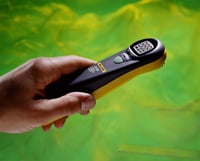
Hear the one about carbon monoxide?
This'll kill you.
And that's no joke. Of all the hazards technicians tackle to protect their customers and themselves - from shock and arc flash to falls, muscle strains, dangerous drivers and those crazy sharp wire ends - few are as stealthy or as potentially lethal as CO.
At low concentrations, CO can cause fatigue in healthy people and chest pain in those with heart disease. At higher concentrations, it can bring on impaired vision and coordination, headaches, dizziness, confusion, and nausea. Breathe in enough of this tasteless, odorless gas, and it can kill.
Excessive CO causes the formation of carboxyhemoglobin in the blood, which inhibits oxygen intake. It seems that every winter we read stories of people without electricity who fire up a space heater, generator, or barbecue grill indoors, drift off to sleep, and never wake up. Why? The concentration of CO has simply shut down their ability to absorb oxygen.
The remedy is threefold. First, precisely measure the levels of CO in the indoor atmosphere, using the pocket size Fluke CO-220 Carbon Monoxide Meter or the multifunction Fluke 975 AirMeter™. If excess CO is detected, find and fix the problem - which is often one or more shortcomings in the HVAC system. Then test again, to verify the solution.
Varying government standards
Government rules that limit CO exposure vary. According to the U.S. Environmental Protection Agency (EPA), the current Occupational Safety and Health Administration (OSHA) permissible exposure limit is 50 parts per million (ppm) parts of air (55 milligrams per cubic meter (mg/m(3))) as an 8-hour time-weighted average (TWA) concentration.
The National Institute for Occupational Safety and Health (NIOSH) sets a recommended exposure limit of 35 ppm as an 8-hour TWA and 200 ppm as a ceiling. The NIOSH limit is based on the risk of cardiovascular effects. The American Conference of Governmental Industrial Hygienists (ACGIH) has an even lower limit of 25 ppm as a TWA for a normal 8-hour workday and a 40-hour workweek, based on the risk of elevated carboxyhemoglobin levels.
Testing at these levels is well within the capabilities of the Fluke CO-220, which detects 0 to 1000 ppm of CO with 5 percent accuracy, as well as the Fluke 975 AirMeter, rated for 0 to 500 ppm CO and a minimum 5 percent accuracy.
Hazards and more hazards
Common sources of excess CO include unvented kerosene and gas space heaters, leaking chimneys and furnaces, and back-drafting from furnaces, gas water heaters, wood stoves, and fireplaces. Worn or poorly adjusted, under-maintained boilers and furnaces can be significant sources. Vehicle exhaust from attached garages and loading docks is another source.
Appliances designed to operate over extended periods of time, like a furnace, boiler, or water heater, must be vented directly to the outdoors. Items with limited operating times, such as residential stoves, ovens, and space heaters, usually emit combustion byproducts in quantities low enough to be vented by normal building ventilation - even the natural infiltration of air through structural leaks. As oxygen is consumed and vent products exit the building, fresh air from outdoors must be continuously supplied or disaster will follow.
Endless possibilities
But problems that cause HVAC systems to malfunction and produce CO - and create problems for facility and maintenance technicians, industrial hygienists, and independent HVAC/R contractors - are not always simple to find and fix.
"The list of possibilities is seemingly endless, and more often than not, it's two or more processes gone wrong. One process may have been operating on the edge of acceptability since day one, and a second process changes enough to throw the first process over the edge. Every job is different."
The first indication of trouble may come when a fixed CO alarm sounds off…or during a periodic check of air quality. By the time the mechanic arrives, the CO problem may be worse…or conditions may have returned to normal. Testing with the CO-220 or Fluke 975 will determine the situation.
What follows is a careful check of key components of the HVAC system, and how they are functioning. A furnace heat exchanger that is leaking or restricted can cause the emission of CO. An inadequate supply of combustion air can throw the combustion process off, producing CO instead of or in addition to CO2 and water, the normal byproducts of complete combustion. Problems with venting of combustion gases, such as poor vent design or vent leaks, can also lead to CO troubles.

A simple tool
For the technician working through these issues, who need to measure CO levels within spaces such as industrial environments, commercial buildings, or residential dwellings, the Fluke CO-220 is an ideal companion. Featuring the newest generation of electrochemical sensors, it responds very quickly to ambient changes in carbon monoxide concentration without the use of a pump.
The Fluke CO-220 features a rugged case and electronics, a large LCD display with backlight, an audible alarm that triggers with increasing frequency as CO levels rise, a MAX Hold function that stores and displays the maximum CO level, automatic sensor zeroing and self-test sequence upon start-up, an easy to replace battery (with typical 500-hour battery life) and replaceable sensor. Precise and affordable, it's designed to help you and your customers breathe easy.